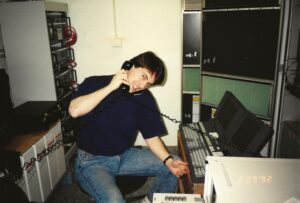Thirty years ago, I was a young, hopeful field support engineer working for a mobile network equipment vendor recently transitioned from a radio software developer. I was staying in Hagalund (a suburb of Stockholm)—or, more specifically, a hot rooftop storage room in Hagalund—waiting for the next software load from our systems integration team so I could load it onto our radio systems and start debugging one of the first 2G GSM networks being deployed by the Swedish mobile operator. It was an exciting time to be in telecommunications, even when it meant waiting around in a hot storage room.
GSM created a common standard so European mobile customers could move seamless between different GSM networks in different countries. At the same time, GSM was creating a single telecommunications equipment market for Europe that would soon extend to the whole world. The open standards defined by GSM opened new markets, created new rivalries, drove prices down, spurred innovation, and increased the quality of mobile communications. Yes, the phones were big, but the potential was even bigger.
GSM opened the interfaces from the Base Station System (BSS) towards the Mobile Switching Center (MSC), but the Base Station Controller (BSC), Base Transceiver Stations (BTSs), and the interfaces between were proprietary black boxes built by the radio equipment vendors. So, it was up to us to provide our own systems integration lab to test and validate our solutions before we brought them into the market. And that’s the way it remained through 3G and even 4G. But that’s all about to change with 5G, which has brought a new way of thinking about how we develop and deploy radio technology: Open RAN.
The O-RAN Alliance is leading the charge to open the black boxes. Their mission is “to re-shape the RAN industry towards more intelligent, open, virtualized and fully interoperable mobile networks.” By supporting open specifications and standards, O-RAN hopes to create a more competitive marketplace for 5G radio technology that drives more innovation while driving down prices much like what GSM did for radio systems.
It sounds promising.
But you don’t spend 30 years in telco without learning a few things. Opening up the network to more vendors also opens the network up to more complexity. Factor in the latest cloud technologies, virtualized RAN components, more software, hardware, equipment and integration partners in the telecom ecosystem, and you soon realize that the most critical piece of the puzzle is integration. If you can’t bring all this openness together, the only thing you’re opening is a Pandora’s box full of interoperability problems.

And this is where I come in, thirty years later, just as excited now to be a part of a new chapter in mobile communications at Dell Technologies as I was in that hot rooftop storage room. You see, while Dell probably isn’t one of those new RAN vendors that O-RAN had in mind initially, we are taking the lead in creating O-RAN solutions with technology partners through our Open Telecommunications Ecosystem Lab (OTEL). OTEL is where the next generation of O-RAN solutions will be built, tested and validated. We’re working today with leading vendors and telecom operators to create integrated, end-to-end solutions for O-RAN and 5G systems.
OTEL is a place where ideas and experts can come together to create new 5G platforms and define the processes that will make 5G a global reality. It’s where cloud-native tools and technologies, DevOps techniques and automation can enable ideas like Open RAN to unleash the full potential of 5G.
It’s a secure environment where any partner or operator can bring their technology and intellectual capital into their own bespoke, isolated lab environment and see the results. In fact, you don’t even need to physically visit OTEL to take advantage of its capabilities; you can access it remotely through a secure connection while sitting anywhere in the world.
Dell is only one of the drivers of this new, open approach. Vodafone is another example, but from the operator side. They recently published a white paper outlining their vision of the systems integration processes needed to deliver a truly interoperable RAN solution for massive deployment in a mobile network. Vodafone envisions lower costs, more automation, reduced risk, and faster time-to-market through these new DevTest processes.
Tibor Fabry-Asztalos, Dell Technologies Senior VP of Product Development Engineering, sums it up best; “Interoperability and System Integration are key to Open RAN’s success, and this requires collaboration amongst the ecosystem partners. Dell Technologies is fully aligned with Vodafone’s vision to facilitate the adoption of open ecosystem in telecommunication networks, especially for Open RAN.”
If I could travel back thirty years, I would tell myself that the hours spent sitting in a stuffy storage room would pay off. That, eventually, mobile technology would work so well that I could work at home on a portable computer or even my phone. Because, at the end of the day, mobile technology has always been about breaking down barriers and bringing people together. Here’s to the next thirty years of open collaboration!
If you would like to learn more about the Open Telecom Ecosystem Lab visit the Dell Technologies OTEL website.


